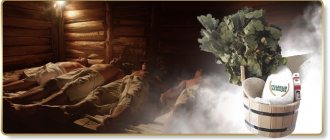Scythians steamed with hemp
Inside the primitive bathhouse - the “soaphouse” - there was a red-hot vat with stones, which created the heat. The room was very cramped and squat. You literally had to climb into it, bending over. Hence the second name of the bathhouse – “vlaznya”.
Water was splashed on the hot stones, as now. This way it warmed up for washing and at the same time filled the sack with wet steam. To make the heat even cooler, hemp seeds were sprinkled on the wet stones. The Scythians sweated profusely, scrubbing their bodies with ash or wet leather belts.
The washing of our ancestors was something between the process of steaming and wallowing in ashes and their own dirt. But in field conditions, these bath procedures were indispensable. Later, when the ancestors of the Slavs began to lead a more sedentary lifestyle, they began to build squat huts made of wood.
Brooms
If you decide to follow the entire procedure and achieve maximum effect, do not forget about the broom. Choosing a broom is a whole science; of course, it is better if you prepare it yourself in June-July. But if you haven’t had such an opportunity, you can buy it, choosing by color and size - all the quality, as they say, is “in your face.”
At the moment, there are many varieties of bathhouse brooms: linden, birch, oak, eucalyptus, coniferous. And they all differ in their impact. For example:
Birch broom has a good effect on the skin, narrowing pores and having a healing effect. Eucalyptus broom vapors help cope with colds and upper respiratory tract diseases. ETC. AND SO ON.
☀ Having chosen a broom that suits your opinion, do not forget to “steam” it before starting the bath procedures.
To do this, pour a sufficient amount of hot water into a basin, where a broom is placed for soaking. As soon as your broom has softened, it is ready for use.
Black bath, or how to wash yourself in soot
Wooden baths were first built without a chimney. The “hood” was the cracks in the windows covered with a bull’s bladder. All the soot from the burned coals under the vat with stones filled the washing room. The walls inside were black with soot.
This is what the “black bath” looked like. Despite its exotic design, it coped well with the hygiene requirements of the time. It was only around the 9th-10th centuries that baths began to be equipped with a pipe, along with which the soot escaped. This is how the Slavs learned to wash in a clean room.
What and how to serve in the steam room
Herbal infusions not only give a pleasant smell, but also have a beneficial effect on the body. The heated essential molecules of plants increase their activity many times over, thanks to which we leave the steam room literally imbued with benefits.
For example, eucalyptus steam contains 40 beneficial components. Peppermint improves mood and calms nerves. Linden greatly enhances sweating and treats colds. There are lovers of beer, kvass and even tobacco vapor. Cigarette smoke is harmful to health, but brewed tobacco heals problem skin.
First, hot water is splashed on the stones to cool them slightly. Then - the diluted infusion, and then - water again. You can also sprinkle the infusion on the walls and floor. But you should not water those present - when mixed with sweat, it will give off an unpleasant odor.
How did you wash then?
Public baths began to be built much later and only in large cities. Initially, washing in a bathhouse was a purely family affair. Everyone washed together: men and women, adults and children.
It never even occurred to anyone to flood the bathhouse separately for women and men. The Slavs did not associate the concept of a bath with shame. It was normal for everyone to wash and steam together. And it’s more practical: not so much firewood is needed to light a bathhouse for everyone.
The steam room and washing room were also combined. Washing, grooming with birch brooms and enjoying hot steam was one continuous, continuous process. In winter, it always ended with diving into the snow or an ice hole (if there was a river nearby).
Preparing yourself for the steam room correctly
You need to go to the steam room prepared. What does it mean?
First, you need to rinse yourself in the shower with warm water, 36-40 degrees. Thus, you begin to gradually adapt your body to higher temperature loads. At the same time, you should not use soap or rub yourself with a washcloth; you can wait until you finish your visits to the steam room. Then you will wash yourself from the heart. And before going in, you don’t need to: you will wipe off the lipid layer from the skin, which plays an important role as a protective barrier.
Secondly , we put a felt bath hat on our head. It is best to do this immediately upon arrival so as not to wet your hair in the shower. Do not forget that you cannot go into the steam room with wet hair - there is a high risk of heat stroke. And if the hat gets slightly wet (of course, you shouldn’t get it wet), then this is only a plus: it will be cooler in a couple’s head.
Thirdly , don’t forget to take a bath mat or towel with you, which we will lay under ourselves (if you have tender feet, don’t forget about felt slippers).
Fourthly , brooms. We select those that we are going to use, inspect the foliage to see if there are many bare twigs. We take them with us to the steam room, where they need to be placed in a steamer, pour boiling water over them and cover with a lid. You won’t need them on the first run, but by the second they’ll be properly worn out.
Sacred action
Foreigners considered the Russian bathhouse to be an abode of debauchery. The Slavs themselves loved “soap” for the health and cleanliness it gave. The concept of hospitality was also associated with it. A decent owner of the house always flooded the bathhouse for his dear guest.
Women gave birth to children in these same buildings. Before an important event, only women and only those who were respected would heat the bathhouse. Men were not allowed to participate in the sacred action. When the room was not occupied, the women gladly used it for fortune telling.
Sometimes this place was also used for secret murders. They could lock the enemy in the bathhouse and burn him along with the wooden building itself. This is exactly what Princess Olga did with the Drevlyan ambassadors, who invited her to become the wife of their leader.
On a note
Overheating often occurs due to low sweating.
The fact is that sweat cools our skin, entering the so-called thermoregulation chain.
If it does not appear, body temperature and blood pressure rise sharply. And the body signals this with dizziness.
To activate sweating, massage your body with a soft mitten or towel. Honey also helps.
The fruit acids it contains exfoliate the skin, free pores from impurities and facilitate sweating.
In principle, any exfoliating procedures help (the easiest way is to exfoliate in the shower right before going in), as well as diaphoretic teas.
It is better not to drink black tea and coffee in the bathhouse: they excite the nervous system, which is absolutely useless for a relaxed body.
Beer is also despised by experienced bathhouse attendants: the alcohol and heavy wort of this drink increase dehydration of the body and block the removal of toxins. It is better to drink mineral water or herbal tea in the bath.
The first mention of a bath is found in Herodotus of Halicarnassus in the 5th century BC. The ancient Greek historian described in great detail the first baths of the Scythians. They were nomads, so they “built” portable baths from 3 poles stuck into the ground, covered with felt around the perimeter.
"Unclean Place"
Since the bathhouse was associated with such mysterious processes for ancestors as conception, birth of children and fortune telling, it was considered an “unclean” place. Here they “washed away sins”, cleansed the body, therefore, something bad remained within these walls.
According to the beliefs of the Slavs, a spirit lived in the bathhouse - the bannik. He was considered an evil creature, capable of killing a person who disrespected him. Bannik was supposed to be cajoled with special sayings and persuasion. In terms of importance, he was even more important than the brownie.
For whom was the bathhouse heated in the old days?
Overseas travelers and historians left many essays about the Russian bathhouse. For unwashed Europeans, the concept of the then ablutions and bathing customs was a novelty. The Russian way of washing the Europeans left them in amazement and indescribable fear. And no wonder, because there was something to be afraid of. Naked men and women, steamed red, furiously whipped themselves with oak or grass brooms. They poured water on the hot coals and ran out of the steam out of the threshold amid wild screams. After all this, we also dived into the ice hole and wiped ourselves with snow. In the eyes of the visitors it looked like torture.
In villages and cities, the bathhouse was arranged differently. In villages, in almost every yard, the owners built themselves a personal bathhouse. This was so as not to bring unnecessary diseases. All families washed and steamed once a week on Saturdays, or when someone got sick. Anyone who had enough land was allowed to build a bathhouse. The buildings were erected near reservoirs, since fires in bathhouses occurred frequently.
Public baths in cities appeared during the reign of Tsar Alexei Mikhailovich in the 17th century. These were three-section buildings with a dressing room, a steam room and a soapbox for men and women. For a small fee they were visited by people of all classes and ages. No one was embarrassed, they even joked about their immodesty. We went to steam with families and friends. Merchants in the steam rooms often resolved business issues, made useful acquaintances, and collected useful news.
Are there any benefits from a Russian bath?
In Rus' it has always been believed that the bathhouse gives health and strengthens the spirit. Modern medicine warns that hot wet steam is beneficial only to healthy people. Hypertension and heart patients are not allowed to enter the bathhouse, as it creates an increased load on the heart and blood vessels.
Those who have varicose veins should not take a steam bath. Bath procedures can only aggravate the problem. It is highly not recommended for pregnant women to visit the steam room, especially in the first and third trimester of pregnancy. A bathhouse is too harsh a test for the body of the expectant mother and fetus. Even a short stay in a hot, humid environment can lead to miscarriage.
But if a person does not have the listed contraindications, he should visit the bathhouse once every month or two. For a healthy body, a Russian bath is comparable to an hour-long workout on an exercise bike or jogging. However, you shouldn’t steam more often: the body gets used to the load and stops responding to it.
Features of Russian doubles
Subsequently, the steam room came into use and became a national symbol , uniting people of different personalities, professions and religions in this activity. Artist V.A. Plotnikov the painting “In the Bath” from 1898 captured this moment. Many other famous artists and performers were not averse to taking a steam bath and rejuvenating both soul and body. In modern society, Russian steam rooms are common in rural areas, but in cities, a movement for a healthy life is slowly developing, and with it Russian steam rooms.
How not to mention the art of massage with brooms ? It’s art because one must also be able to masterfully wield this bath item. Brooms, as before, are used from birch, fir, oak, and linden. The choice largely depends on the health benefits you want to achieve. We know the healing natural effect of steam. Together with a wonderful broom and an experienced bath attendant, time will fly by unnoticed and useful. The canvas by Alexey and Sergei Tkachev “Family Bath” from 1982-83 conveys all the beauty and life of the family. All the attributes for a pleasant time in the bathhouse are visible.
Russian bath options
As the ancestors said, purification of the soul and body . Of course, our mother nature also helps in many ways; what would we do without medicinal plants and herbs. It turned out well to depict a truly Russian maiden after a steam room by the artist V.A. Plotnikov. in the painting “In the Bath” from 1898.
According to research, the steam room removes from the body:
- slags;
- excess water;
- toxins;
- takes away fatigue and stress.
As Arkady Plastov showed in the painting “Spring” of 1954, the most important feature that the Russian steam room has is, of course, the design itself. From time immemorial, the steam room was built from a wooden frame, which gives a colossal effect during the bathing process. Many foreign travelers have written about our Russian bathhouse.
Traditional Russian steam room is divided into three types:
- in black
- in white;
- inside the oven.
Bath traditions
There are many bath traditions. Not a single important event took place without a bathhouse throughout the life of the Slavs. The bathhouse was considered by the Slavs not only a way of washing, but also a ritual place. Childbirth, weddings, marital ablutions and even farewells to the deceased took place in the bathhouse.
The future mother-in-law invited her daughter-in-law to the bathhouse to examine her daughter-in-law’s health, endurance and fortitude. On the eve of the wedding, the girls had a kind of bachelorette party with fortune telling and rituals, and the groom also gathered separately in the bathhouse with friends and said goodbye to his single life. After the wedding, the next day the young people went together to the steam room accompanied by songs and rituals. Their parents greeted them at the entrance with bread - “bannik” and chicken meat. After each intimacy, before going to church, the spouses traditionally went to the steam room together.
The bathhouse was considered the cleanest place for childbirth. The woman in labor was placed in a well-heated bathhouse for the time being and after childbirth. First, the bathhouse was heated, straw was laid down, and a midwife was brought in with the woman in labor. After birth, the naked midwife performed a ritual spell with the baby. In it, she asked for health and a happy fate for the newborn. After the conspiracy, the mother and child bathed together, steamed and spoke conspiracies for fate, health and happiness. The child was kept with his mother for three to seven days in a bathhouse and only then was solemnly brought into the hut to his father.
Since the reign of Vladimir the Great, baths have been used as a remedy for illnesses. Any ailment, especially a runny nose, colds or joint diseases, was treated with a broom and steam. This tradition was adopted by monks and healers.
The bathhouse was especially popular among unmarried girls for Christmas fortune-telling. It was believed that the spirit “bannik” lived in the bathhouse. With his help, the girls tried to predict their future fate: whether they would get married soon, what kind of character the betrothed had, and whether he would beat his wife. With the help of special words in the bathhouse, girls in love could even bewitch the guy she liked.










